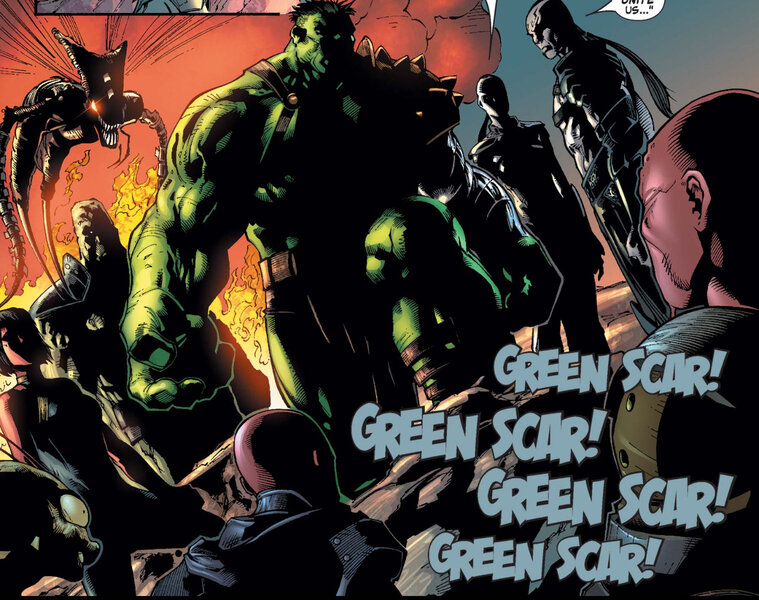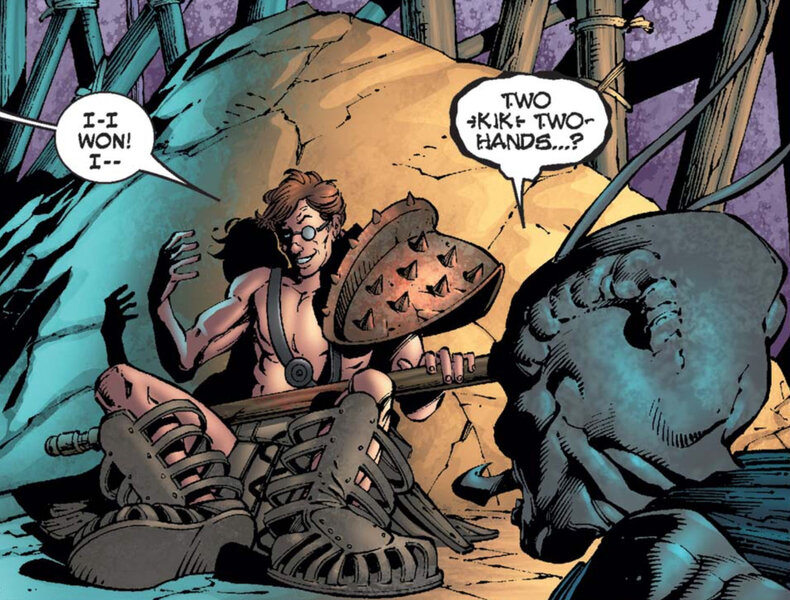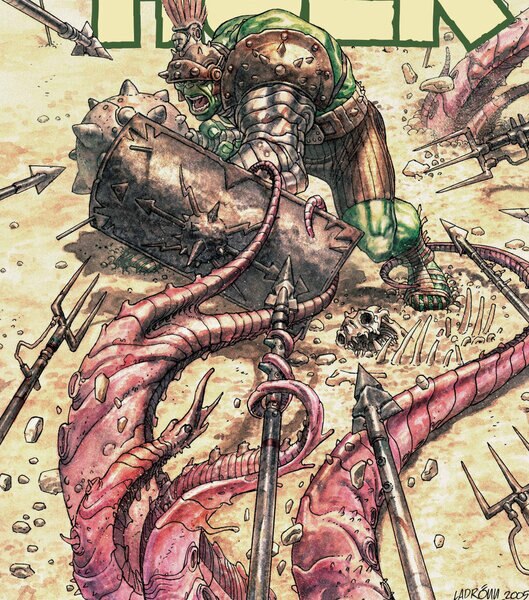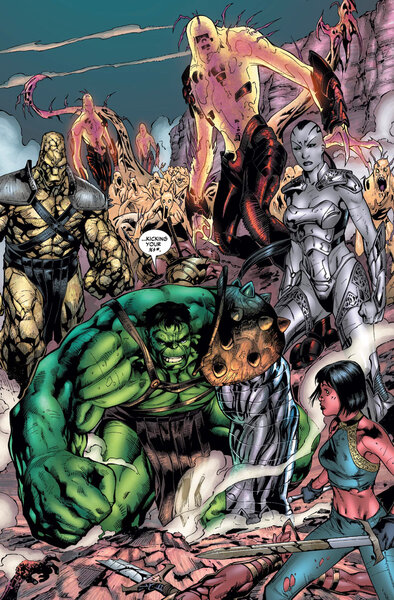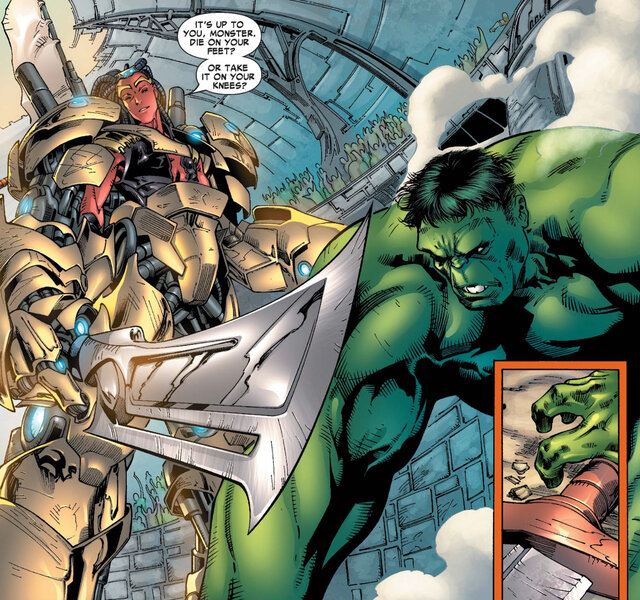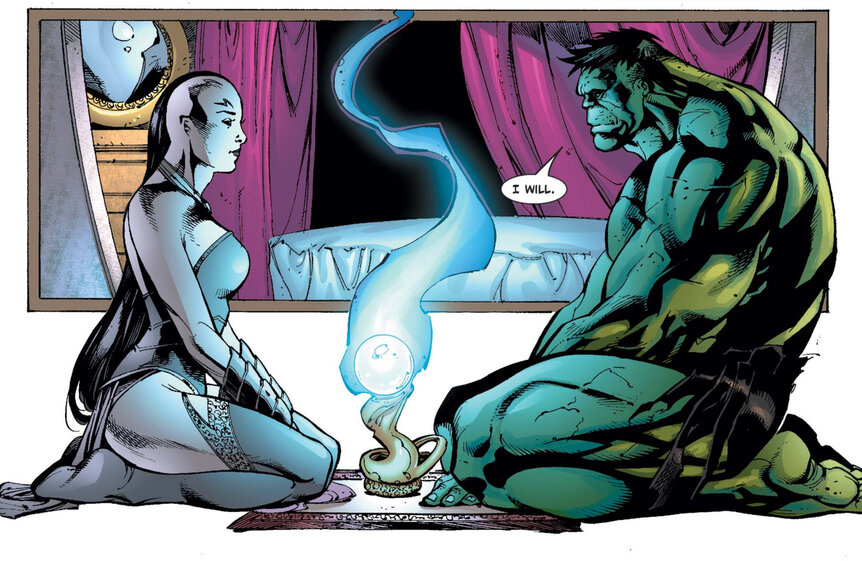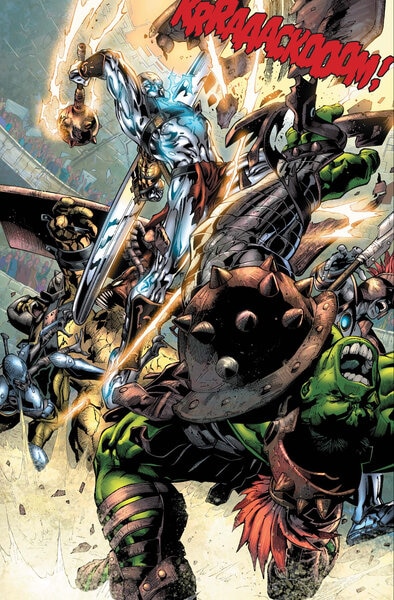Create a free profile to get unlimited access to exclusive videos, sweepstakes, and more!
An oral history of how Planet Hulk changed Bruce Banner and the Marvel Universe forever
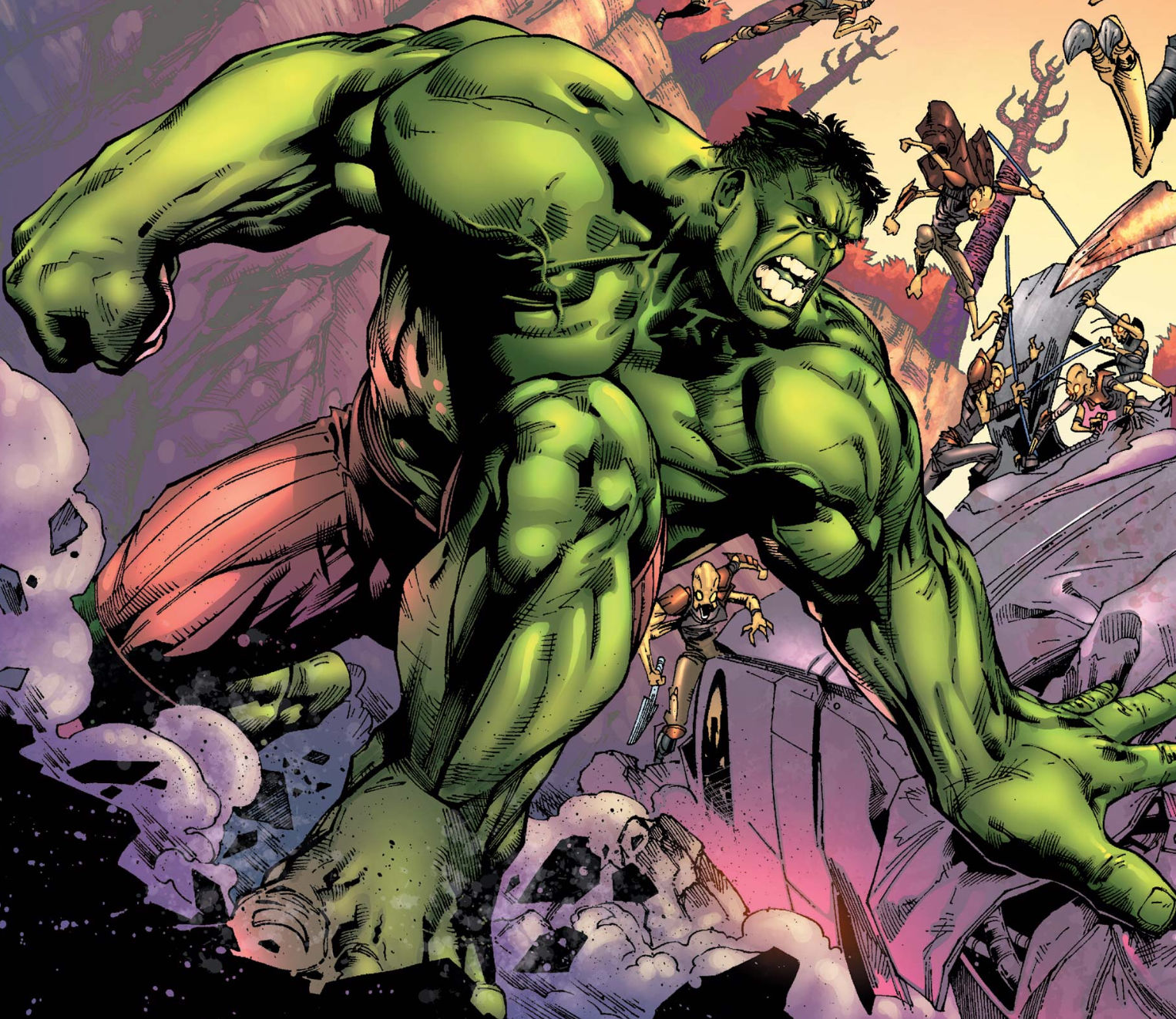
Though one of the most recent additions to the Hulk's comic history, Planet Hulk stands as an already iconic storyline for hardcore readers and casual fans alike. The year-long saga, which began in part with The Incredible Hulk #91 before kicking into full gear the following issue, took the Hulk off Earth and into the harsh, unrelenting, and unpredictable planet of Sakaar.
By the end of the story, Bruce Banner's alter ego was entirely redefined, becoming a gladiator hero, a liberator, and a husband — then, in the spirit of his perpetually sad saga, it was all ripped it all away. Later, this storyline would become a big part of Thor: Ragnarok.
SYFY WIRE tracked down many of the major names behind Planet Hulk to reflect all these years later on the iconic run.
Below, editor Mark Paniccia, writer Greg Pak, and artists Carlo Pagulayan and Aaron Lopresti discuss how this game-changing storyline came about, as well as their thoughts on how the story has endured in the hearts of fans and grown to have a new life beyond the comic page.
Mark Paniccia: I started on the Hulk with Issue #82, right after writer Peter David [a vet of decades of Hulk stories] and artist Lee Weeks ended their Tempest Fugit.
New to the title, Mark was tasked with planning where the Hulk would go next after his inclusion in tie-in events like House of M had run its course.
Paniccia: At one of my first Marvel editorial summits, Editor-in-Chief Joe Quesada said he felt we needed to really let Hulk cut loose. And I agreed. You have this walking atom bomb that, if you let it go to its fullest potential, would wreak all kinds of havoc, destruction, and casualties. So we kicked around some ideas and thought the best thing to do would be to get him off-planet.
To bring such a story to life, Mark would need an entirely new creative team, beginning with writer Greg Pak.
Paniccia: Greg [Pak] was a relatively new writer who we had great faith in. I'd worked with him on another book, Marvel Imperfects [a tie-in comic based on the 2005 video game Marvel Nemesis: Rise of the Imperfects], and over the course of the five issues developed a close collaborative relationship with him. He was a big thinker with an amazing ear for dialogue. I think Greg's dialogue is some of the best in the business. That's so important to good storytelling.
Pak: The Hulk has already been my favorite Marvel character. I grew up watching the Bill Bixby, Lou Ferrigno show, and I just loved it as a kid. Once I started working for Marvel, I would drop these hints with editors about how cool it would be to write the Hulk.
Paniccia: The problem with a story where the Hulk really cuts loose is that he's a hero. We didn't want him killing innocents (a point that stuck with me and Greg helped resolve later on).
Pak: One day I'm pulled into a meeting at Marvel. Joe Quesada and I think Executive Editor Axel Alonso are there. The setup they gave was "Hey, we've got this crazy plan, we're gonna shoot the Hulk into space, would you be interested in that kind of a story?" I believe my reply was "Would I?" He would land on this planet and it would be a gladiator adventure. That's pretty much all they gave me.
Paniccia: On a world where Hulk fans could see their favorite character smash the hell out of stuff like nowhere else.
Pak: So I put together this whole outline where basically the Hulk goes from being enslaved to becoming a gladiator, then leading a revolution and eventually becoming ruler of the planet. Marvel basically approved that. It was amazing because I got to create this whole new planet, build the supporting cast, and figure out what the heck the real emotional story was. Working with Mark, we really bonded over this project.
The new planet and new Hulk were groundbreaking, but they had a lot of old-school inspirations.
Pak: This is a thing that I wrapped my head around while I was working on the Hulk: When faced with different kinds of stresses in his life, Banner manifests the Hulk in different ways. Dumb Hulk, Genius Hulk. The trick is figuring out what the rules are within that incarnation and the pattern of speech. It took a while.
I thought about Clint Eastwood and all those spaghetti westerns I grew up watching. That became a touchpoint for me. One amazing thing that I noticed about Eastwood's characters were that he'd never help you in a conversation. Somebody would talk to him and he'll just stare at them. He'll never help the conversation along. And the Hulk is the same way. He doesn't want to talk, and he'll let you mutter on into silence. So once I kind of figured that out, it made writing the Hulk so much easier.
Paniccia: We had also made a conscious decision to not have Hulk revert back to Banner unless the story called for it. We wanted it to be Hulk 24/7.
And from a pure storytelling point of view, there was so much to be learned about how Banner felt from Hulk's actions. There was a noble spirit within the monster. And that's how I saw Banner. And to the earlier point about Hulk not killing civilians, Greg came up with the excellent idea that during all those battles on Earth, Banner's mind was calculating trajectories and force and gravity and physics trying to control the outcome so no one would die from a building toppling or maimed by debris. I thought that was really clever and great and gave Banner so much depth.
A writer and concept established, they went to recruit an art team.
Paniccia: Carlo Pagulayan was another talent we wanted to support. At the time he was working on some Marvel Adventures stories with me and my assistant, MacKenzie Cadenhead. That line was for all ages, but we wanted them to look and feel like what you'd expect from any Marvel book. To this day I'm still very proud of the stuff that came out.
Pagulayan: I was working on pages for Marvel Adventures Fantastic Four when I was asked to submit a sketch for a Gladiator Hulk. It wasn't really clear to me if I was doing a design or just a pin-up. And I never really asked what it was for. So I decided to draw Hulk fighting a tiger, pulling inspiration from the movie Gladiator. I submitted it, but I thought the Hulk didn't look right, so I redrew it and submitted it again a few hours later.
Paniccia: MacKenzie really loved Carlo's stuff, and when she showed me his art I fell in love too.
Pagulayan: Then I got the news I was to draw Hulk. I had no clue it was going to be an arc or a big event. The design I did wasn't the one that ended in the book; that credit goes to [eventual cover artist for the storyline] Jose Ladronn, as far as I know.
Paniccia: I was so happy to have gotten Ladronn for the entire run's covers. He gave the book a specific tone. I can't think of anyone else who could have done what he did.
Lopresti: I had known Mark as the editor on the book at the time from my Malibu Ultraverse days back in the '90s. He asked me to do some covers for the Marvel Adventures line on their Avengers books. So while I don't have a reputation for much, I do have a reputation for meeting deadlines and being trustworthy. What they wanted to do is get somebody else to come in for Carlo and do rotating story arcs. That was his pitch. He's like, "Hey, do you want to do rotating story arcs on this kind of gladiator Hulk thing?" To which I quickly replied, "Uh, yeah!"
Paniccia: Aaron is an amazing artist. Very talented and imaginative. A good fit with Carlo.
Lopresti: I grew up in the '70s. Most of my influences are like Frank Frazetta and Barry Windsor-Smith. This was a Hulk Barbarian story. Hulk meets Spartacus. This is exactly the kind of stuff I love to draw.
Paniccia: He'd been working for Marvel for a while and we wanted to give him something juicy to sink his teeth into.
Greg Pak: Carlo and Aaron were just tremendous artists to work with. Because they love the material, they dug in and they designed so many different characters and monsters and were a huge pleasure to work with.
Lopresti: I connected with Greg quickly. I went to film school at USC, and I found out he went to film school at NYU. So we started connecting over film school stories and got along really well.
Pagulayan: Working with Greg was a learning experience. Because he's also a film director, and it showed in his scripts. Prior to him, the writers I've worked with wrote their script direction without much technical camera terms. With Greg, there were camera terms that I never thought could go together. Working with Greg pushed me to take on and learn photography.
Paniccia: I don't want to forget colorist Chris Sotomayor.
Pak: Chris Sotomayor, who was the colorist, he had this big idea that the Hulk should be the only green thing on the planet. I thought that was awesome, was such a great idea.
Paniccia: As Greg might've mentioned, Chris read the initial plots and came up with the idea that Hulk would be the only thing that's green on the planet. Greg and I thought that was brilliant storytelling through color.
Pak: It really made the Hulk stand out. Then we introduced green elements as the story goes along, like the planet is accepting the Hulk and he is accepting his role there. Subtle things like that.
So with the creative team in place, the story itself had to be crafted based off a three-issue lead-in. The Marvel Universe's secret brain trust of Reed Richards, Tony Stark, Doctor Strange, and the Inhuman king Black Bolt collectively deciding that the Earth has endured one rampage by the Hulk too many (with the latest tantrum flattening the Las Vegas strip). They trick Banner into a spaceship bound for an uninhabited far-flung planet where the Hulk can do no harm.
The Hulk responds to this the only way he knows how: wrecking his ship and knocking it off course.
Pak: We came up with this idea of this wormhole, or "Great Portal," as the natives would refer to it, as a way for the Hulk to gets to Sakaar. A portal that draws in powerful creatures and things from other parts of the universe, making Sakaar this giant trash pit where all this stuff goes down. As a result, there's this ragtag culture made up of bits and pieces of technology that have come from other worlds mixed in with pre-industrial weaponry and armor. I immediately gravitated toward this battle axes and blasters sort of aesthetic. I wanted to keep it more sci-fi than magic. I wanted to avoid any sort of high fantasy.
That "trash pit" aesthetic would really help to shape the planet Sakaar, bringing in familiar elements from the Marvel Universe.
Paniccia: It was important that we bring in some familiarity to the story.
Pak: From the beginning, I knew that I wanted to create a lot of new stuff, but I also wanted to pull in some fun elements from Marvel's history.
Paniccia: Greg tapped into stuff that wouldn't be a problem coordinating with other editorial offices.
As a result, the first allies the Hulk encounters on this strange new world were made up of many established Marvel alien mainstays.
Pak: The idea of re-introducing Korg as one of the original Kronans that had met Thor [during his first Marvel appearance in Journey Into Mystery #83], and now he was on this planet. We brought in the Brood [a race of parasitic beings from the X-Men corner of the universe]. Those characters were key because they are sort of classic Marvel villains.
Paniccia: Characters like Korg and the Brood were such great ways to remind readers that this bold new world of Sakaar existed in the rich cosmos of the Marvel U.
Pak: The whole point is that you've got these monsters. They're stuck on this planet, and thus they come together and bond. It's the journey of how a monster becomes a hero and how this group of monsters becomes heroes. So drawing on characters that have a history as villains within the Marvel universe was key. The Hulk starts off bonding with this small group of Warbound, as they would come to be known. Bonding not just with each other but with all the oppressed people on this planet. The Warbound play a critical part of that.
Pagulayan: We started working on the book, and I was given some free rein on establishing the look based on what Greg described. There were some scribbles from Greg to get a general idea, while I expounded on them, tried to think of how a creature or race evolved or how they lived, their backstories.
Pak: I wanted a good foil for the Hulk. So the Red King Harvard, just his whole manner and his social status, I wanted that to stand in opposition to the Hulk. He's an elitist. The child of a great King before him. That's why I wanted to play him as this spoiled brat. This elitist imperialist, who had nothing but contempt for these monsters/ gladiators, like the Hulk and the other Warbound. I wanted to create somebody who was everything the Hulk was not in a negative way, and who sort of gloried in that.
Lopresti: The unfortunate thing for me was that I came in after Carlo did the first story arc. So he did a lot of the initial worldbuilding. My story arc was started outside the city limits and sort of dealt with the origins of Meek, the bug guy, so I had quite a bit of guidance. I can't say ran amuck, but essentially I would take what Carlo did, say in the city scenes, and I would try to adapt that sort of architectural style into the country scenes or the villages and these different kinds of things. So there was some sort of continuity there, but everything I was designing was based off what had been done initially.
Pak: Bruce Banner has had a lot of romantic interactions over the years. But they've almost always fallen in love with Banner, with the Hulk often being the third wheel or the big problem in the relationship. I wanted to turn that around because a big part of the story of Planet Hulk is that he's ended up on a planet where his strengths and his anger are actual virtues. This planet needs the Hulk specifically.
It was important that Caiera be this formidable warrior who over time begins to appreciate the Hulk as the Hulk. She falls in love with the Hulk, not Banner. They actually have a kind of wedding ceremony, and as part of that the Hulk reveals Banner, and Caiera accepts both of them. I think to this day, she's still the only character who has accepted both Banner and the Hulk in that kind of a way. That was important. She's a warrior who's seen everything, and she is incredibly strong herself. She's physically a match for the Hulk. But emotionally and intellectually, she's right there with him as well. She can stand as his greatest enemy or, as things eventually played out, his greatest love.
Paniccia: Silver Surfer was an absolute must-have. With the Great Portal, we could bring anything or anyone through. Greg and I were itching for a Hulk vs. Surfer battle to blow people away with.
Pagulayan: The Silver Surfer's first blow against the Hulk is very memorable for me. I really enjoyed drawing that battle.
Pak: Including the Surfer made total sense to me because he and the Hulk have a long history, not just in Defenders. There's this great issue from back in the day where the Surfer gets attacked by the Hulk. There's this moment [in Tales to Astonish #93] when the Surfer recognizes that the Hulk is miserable on Earth. He thinks about possibly just taking Hulk away, in a "Maybe I can help him" sort of way. Then the Hulk attacks him and Surfer's like "Forget it!" But Planet Hulk gave us a chance to finally bookend that story. So that was very cool.
Paniccia: The hope always is that you're doing something fans are going to love. Greg and I knew we were building something special though. Each time we talked about it there would be another big, cool idea we would try to figure out how to fit in. If we were excited by it, we knew fans would be, too. We were always thinking about the fans and what they would want to see, what would get them talking.
Lopresti: For me, the singular moment that I worked on was the scene at the end of issue #102, where he makes the deal with the alien Spikes to sustain them with his Gamma irradiated blood. He's on his throne, and these vampire things are sucking the blood out of his arms, sitting there in the shadows looking all creepy and (Bernie) Wrightson-y Caiera is by his side comforting him. That to me was the powerful standout moment that I got to illustrate.
Pak: This was originally it was going to be eight issues. But at one of the Marvel creative summits, the whole idea of Mark Millar and Steve McNiven's Civil War event came up. It became clear that it would probably be good to have the Hulk off the table for a while.
Paniccia: Greg did such a fantastic job with the world-building that it pained me to have to cut stuff out. When we were given more issues, we were able to bring everything back and it all worked out perfectly. I don't know if we would have had the pathos and poignancy that we wound up with if we hadn't been given more issues to build from.
Pak: 14 issues altogether. Which was honestly fantastic. It really got a chance to breathe with those extra issues.
Lopresti: When we started working this thing and was getting the script, all I was saying to Greg the whole time we were working on this book was "This is going to be to the Hulk what Simonson's Beta Ray Bill storyline was to Thor." And that's not to say that Peter David didn't do some really cool stuff. But this was a perfect Hulk story in my opinion. It's the kind of project where you realize it's really special. I often found myself sitting back and saying I'm so fortunate to be involved with this.
Pak: When the issue started to come out, we realized they were resonating. The Hulk at the time did not sell well when we started. Over the course of the run, it gained readers, which just doesn't happen in comic books. That's really rare.
Since its release, Planet Hulk has spawned sequels (chief among them being World War Hulk), been adapted into books, animated movies, and most recently the big screen, with various elements of the story being added to Thor: Ragnarok back in 2017.
Pagulyan: I enjoyed the movie, but I know I'm not alone when I say I wish it was Hulk-centric. An actual Planet Hulk. Maybe leading into an Avengers: World War Hulk story. I actually mentioned it to Mark Ruffalo during the premiere.
Paniccia: It was so much fun seeing that stuff up on the screen. Such a great feeling to see things that were just scribbled notes and sketches at one time come to life.
Pak: I never dreamed it would go this far. When I was writing this in the first place, it was before the first Iron Man movie. The MCU didn't exist as it does. We didn't know that there would be those kinds of opportunities for these stories. It's nuts that there have been so many places where this story has been retold, adapted, or expanded upon. I'm incredibly grateful to all the folks who have supported and enjoyed this story over the years.
